BibleArcheology 10/13/10
Why Archaeology?
I know... I hear it all the time.
I hate history. I'm not into archaeology. Why do I have to care about something that happened thousands of years ago?
For me, biblical archaeology is more than a study topic and more than a job. Archaeology is how I first saw Jesus-- really saw Him. How I continue to see Him.
Brutally honest and possibly offensive admission alert: I have a hard time seeing Jesus in church. I go to church because Hebrews 10:25 advises us not to "forsake the assembling of ourselves together." I like the sermons and I like the music, and every now and then I see an old friend I haven't seen in a while.
But it's hard for me to see Jesus there. My sometimes too-logical mind thinks that in the first century when Jesus walked on earth, there was no gospel music and no Christian-ese terminology like "press in" or "backslide." If you were "on fire" back then, that meant you were tied to a stake, having ended up on the wrong side of the Roman emperor. There were no evangelists who can get five syllables out of the word "Jesus," no warehouse-looking mega-churches, and no twenty-minute altar calls.
Not, as Jerry Seinfeld and George Costanza would say, that there's anything wrong with that.
I just see Jesus differently. I see Him in the stones.
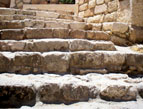 On Mount Zion in Jerusalem, I can walk through the ruins of the home of Caiaphas the high priest, where Peter denied Jesus. Outside are uneven stone steps that lead right to Caiaphas' doorstep; most archaeologists agree they're the same ones that Jesus would have walked 2,000 years ago. Today, I can walk there and imagine soldiers leading Jesus down those steps. In my mind, I can see Jesus turn his head and give Peter the look that made him weep.
On Mount Zion in Jerusalem, I can walk through the ruins of the home of Caiaphas the high priest, where Peter denied Jesus. Outside are uneven stone steps that lead right to Caiaphas' doorstep; most archaeologists agree they're the same ones that Jesus would have walked 2,000 years ago. Today, I can walk there and imagine soldiers leading Jesus down those steps. In my mind, I can see Jesus turn his head and give Peter the look that made him weep.
Inside are the ruins of the high priest's house, where Jesus was imprisoned the night before His death. Underground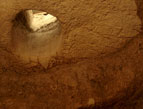 is a large cistern used to store water, or, in some cases, to hold prisoners. Today, you can enter the pit from a winding staircase, but in Jesus' day, the main point of entry was a large hole in the ceiling through which the captives were lowered, and often suspended in midair for hours, by ropes. When you stand inside the so-called "Sacred Pit" today, the words of the psalmist come alive -- words that Jesus fulfilled almost a thousand years after they were written: "You have laid me in the lowest pit, in darkness, in the depths" (Psalm 88:6).
is a large cistern used to store water, or, in some cases, to hold prisoners. Today, you can enter the pit from a winding staircase, but in Jesus' day, the main point of entry was a large hole in the ceiling through which the captives were lowered, and often suspended in midair for hours, by ropes. When you stand inside the so-called "Sacred Pit" today, the words of the psalmist come alive -- words that Jesus fulfilled almost a thousand years after they were written: "You have laid me in the lowest pit, in darkness, in the depths" (Psalm 88:6).
Two hours north of Jerusalem, I can walk the shores of the Sea of Galilee at a place called Tabgha, where Jesus painted my favorite picture of forgiveness after Peter's denial. It wasn't a long sermon on what childhood trauma you had to dr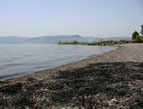 edge up to figure out who hurt you, or a list of the innumerable steps to forgiveness. For Jesus, forgiveness wasn't a therapy session; it was an action. Jesus prepared a meal for Peter, which, in Judaism, is an ironclad act of reconciliation. Come and eat. Then Jesus asked him a question. Do you love me? Three times, once for every time Peter denied him. Finally, He gave Peter a job. Feed my sheep.
edge up to figure out who hurt you, or a list of the innumerable steps to forgiveness. For Jesus, forgiveness wasn't a therapy session; it was an action. Jesus prepared a meal for Peter, which, in Judaism, is an ironclad act of reconciliation. Come and eat. Then Jesus asked him a question. Do you love me? Three times, once for every time Peter denied him. Finally, He gave Peter a job. Feed my sheep.
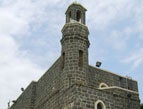
As is the case with most holy sites, a church marks the spot, the Church of the Primacy of St. Peter. Outside are six flat stones near the shoreline, which are meant to symbolize the three denials and three affirmations.
Back in Jerusalem, I can walk up to the Eastern Gate of the Old City walls, now an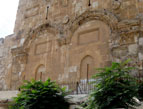 Ottoman-era gate, sealed shut for centuries. Hidden beneath the gate are the foundations of what was known as the "Beautiful Gate" in Jesus' day. Today, the area is a badly neglected cemetery with ornately carved gravestones floating in a sea of trash. But as I stand there, I see the old gate -- the spot where Peter pulled a crippled beggar up by the hands. In the name of Jesus Christ of Nazareth, rise up and walk. No investigation of what sin or long-held grudge was crippling the man, no sermon on the "27 Steps to Healing." Just one step. Get up and walk.
Ottoman-era gate, sealed shut for centuries. Hidden beneath the gate are the foundations of what was known as the "Beautiful Gate" in Jesus' day. Today, the area is a badly neglected cemetery with ornately carved gravestones floating in a sea of trash. But as I stand there, I see the old gate -- the spot where Peter pulled a crippled beggar up by the hands. In the name of Jesus Christ of Nazareth, rise up and walk. No investigation of what sin or long-held grudge was crippling the man, no sermon on the "27 Steps to Healing." Just one step. Get up and walk.
Weakness, fear, failure, unconditional forgiveness, restoration, divine empowerment and perfect healing. To me, no sermon could tell that story as powerfully as the stones, the stairs, the gate and even the pit.
That's why I love archaeology. I love facts and dates and stones and mosaics and scrolls and ruins and tombs. I love studying the historical Jesus, because that studying -- that poring over Scripture, searching for something new and finding it every time -- helps me better understand the same Jesus who walks with me today.
I hope these stories help you see Jesus more clearly as well. From time to time, we'll stray from biblical archaeology and venture into Christian history -- Jerusalem, Rome, Constantinople, Ephesus and even London -- and those are just the ones on my calendar today.
Who knows where we'll go after that?
I hate history. I'm not into archaeology. Why do I have to care about something that happened thousands of years ago?
For me, biblical archaeology is more than a study topic and more than a job. Archaeology is how I first saw Jesus-- really saw Him. How I continue to see Him.
Brutally honest and possibly offensive admission alert: I have a hard time seeing Jesus in church. I go to church because Hebrews 10:25 advises us not to "forsake the assembling of ourselves together." I like the sermons and I like the music, and every now and then I see an old friend I haven't seen in a while.
But it's hard for me to see Jesus there. My sometimes too-logical mind thinks that in the first century when Jesus walked on earth, there was no gospel music and no Christian-ese terminology like "press in" or "backslide." If you were "on fire" back then, that meant you were tied to a stake, having ended up on the wrong side of the Roman emperor. There were no evangelists who can get five syllables out of the word "Jesus," no warehouse-looking mega-churches, and no twenty-minute altar calls.
Not, as Jerry Seinfeld and George Costanza would say, that there's anything wrong with that.
I just see Jesus differently. I see Him in the stones.
 On Mount Zion in Jerusalem, I can walk through the ruins of the home of Caiaphas the high priest, where Peter denied Jesus. Outside are uneven stone steps that lead right to Caiaphas' doorstep; most archaeologists agree they're the same ones that Jesus would have walked 2,000 years ago. Today, I can walk there and imagine soldiers leading Jesus down those steps. In my mind, I can see Jesus turn his head and give Peter the look that made him weep.
On Mount Zion in Jerusalem, I can walk through the ruins of the home of Caiaphas the high priest, where Peter denied Jesus. Outside are uneven stone steps that lead right to Caiaphas' doorstep; most archaeologists agree they're the same ones that Jesus would have walked 2,000 years ago. Today, I can walk there and imagine soldiers leading Jesus down those steps. In my mind, I can see Jesus turn his head and give Peter the look that made him weep.Inside are the ruins of the high priest's house, where Jesus was imprisoned the night before His death. Underground
 is a large cistern used to store water, or, in some cases, to hold prisoners. Today, you can enter the pit from a winding staircase, but in Jesus' day, the main point of entry was a large hole in the ceiling through which the captives were lowered, and often suspended in midair for hours, by ropes. When you stand inside the so-called "Sacred Pit" today, the words of the psalmist come alive -- words that Jesus fulfilled almost a thousand years after they were written: "You have laid me in the lowest pit, in darkness, in the depths" (Psalm 88:6).
is a large cistern used to store water, or, in some cases, to hold prisoners. Today, you can enter the pit from a winding staircase, but in Jesus' day, the main point of entry was a large hole in the ceiling through which the captives were lowered, and often suspended in midair for hours, by ropes. When you stand inside the so-called "Sacred Pit" today, the words of the psalmist come alive -- words that Jesus fulfilled almost a thousand years after they were written: "You have laid me in the lowest pit, in darkness, in the depths" (Psalm 88:6). Two hours north of Jerusalem, I can walk the shores of the Sea of Galilee at a place called Tabgha, where Jesus painted my favorite picture of forgiveness after Peter's denial. It wasn't a long sermon on what childhood trauma you had to dr
 edge up to figure out who hurt you, or a list of the innumerable steps to forgiveness. For Jesus, forgiveness wasn't a therapy session; it was an action. Jesus prepared a meal for Peter, which, in Judaism, is an ironclad act of reconciliation. Come and eat. Then Jesus asked him a question. Do you love me? Three times, once for every time Peter denied him. Finally, He gave Peter a job. Feed my sheep.
edge up to figure out who hurt you, or a list of the innumerable steps to forgiveness. For Jesus, forgiveness wasn't a therapy session; it was an action. Jesus prepared a meal for Peter, which, in Judaism, is an ironclad act of reconciliation. Come and eat. Then Jesus asked him a question. Do you love me? Three times, once for every time Peter denied him. Finally, He gave Peter a job. Feed my sheep.
As is the case with most holy sites, a church marks the spot, the Church of the Primacy of St. Peter. Outside are six flat stones near the shoreline, which are meant to symbolize the three denials and three affirmations.
Back in Jerusalem, I can walk up to the Eastern Gate of the Old City walls, now an
 Ottoman-era gate, sealed shut for centuries. Hidden beneath the gate are the foundations of what was known as the "Beautiful Gate" in Jesus' day. Today, the area is a badly neglected cemetery with ornately carved gravestones floating in a sea of trash. But as I stand there, I see the old gate -- the spot where Peter pulled a crippled beggar up by the hands. In the name of Jesus Christ of Nazareth, rise up and walk. No investigation of what sin or long-held grudge was crippling the man, no sermon on the "27 Steps to Healing." Just one step. Get up and walk.
Ottoman-era gate, sealed shut for centuries. Hidden beneath the gate are the foundations of what was known as the "Beautiful Gate" in Jesus' day. Today, the area is a badly neglected cemetery with ornately carved gravestones floating in a sea of trash. But as I stand there, I see the old gate -- the spot where Peter pulled a crippled beggar up by the hands. In the name of Jesus Christ of Nazareth, rise up and walk. No investigation of what sin or long-held grudge was crippling the man, no sermon on the "27 Steps to Healing." Just one step. Get up and walk.Weakness, fear, failure, unconditional forgiveness, restoration, divine empowerment and perfect healing. To me, no sermon could tell that story as powerfully as the stones, the stairs, the gate and even the pit.
That's why I love archaeology. I love facts and dates and stones and mosaics and scrolls and ruins and tombs. I love studying the historical Jesus, because that studying -- that poring over Scripture, searching for something new and finding it every time -- helps me better understand the same Jesus who walks with me today.
I hope these stories help you see Jesus more clearly as well. From time to time, we'll stray from biblical archaeology and venture into Christian history -- Jerusalem, Rome, Constantinople, Ephesus and even London -- and those are just the ones on my calendar today.
Who knows where we'll go after that?